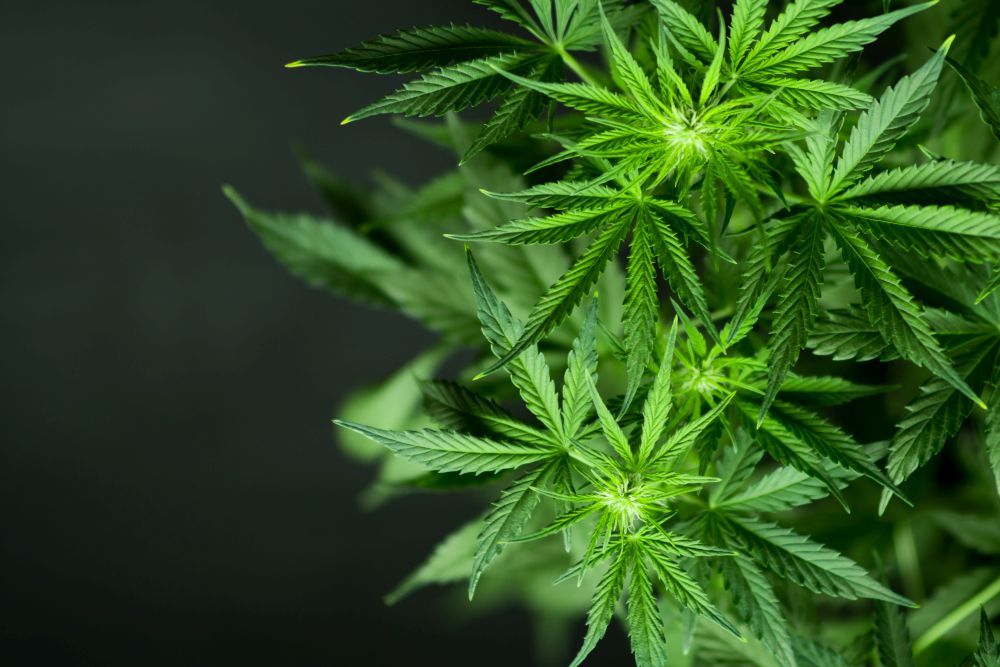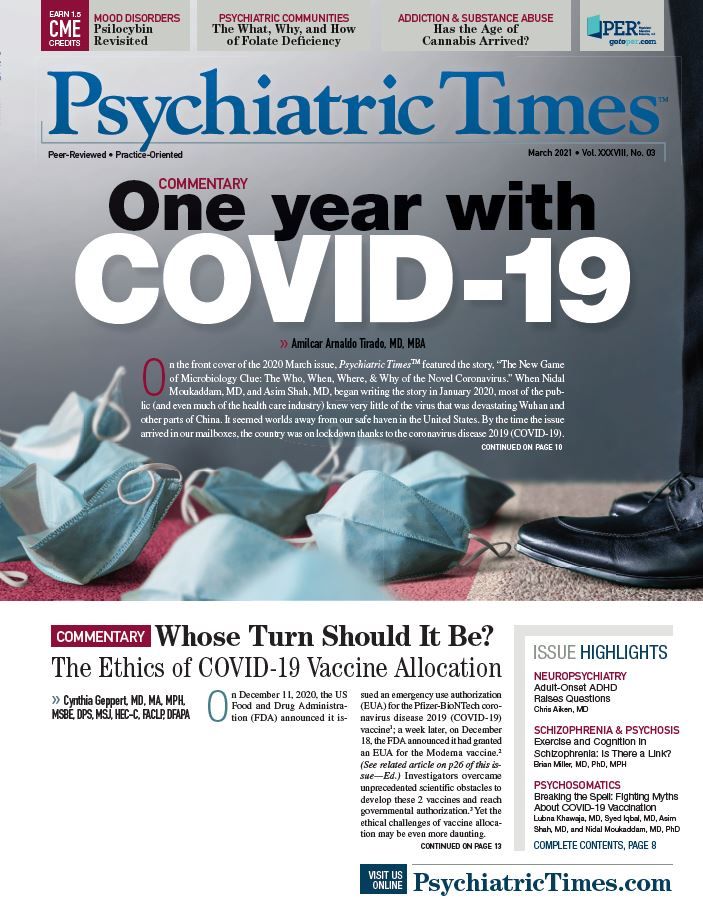SPECIAL REPORT: CANNABIS CONUNDRUM
Case Vignette
“Mr Green” is a 39 year-old African-American male with a history of chronic schizophrenia, cannabis use disorder, and alcohol use disorder. He started smoking cannabis almost daily at age 20. When he was 22, he was in a motor vehicle accident while under the influence of substances and suffered a head injury. Several months later, he was hospitalized for a first episode of psychosis (FEP). Thereafter, he participated in a long-term antipsychotic clinical trial.
For more than a decade, he has been maintained on a long-acting injectable antipsychotic and is adherent with appointments. He tends to get paranoid during stressful times, but he has not had any subsequent psychiatric hospitalizations. However, he has continued to use cannabis regularly—daily to weekly—for almost 20 years. Although he worked prior to the onset of his psychotic disorder, he has since been chronically unemployed. He lives at home with his parents, has never married, and does not have any children. He remains precontemplative regarding the need for treatment for alcohol and cannabis use disorder.
ALSO IN THIS SPECIAL REPORT
Clinical Management of Cannabis Complications
Special Report Chairs
Thomas R. Kosten, MD, and Christopher D. Verrico, PhD
The Age of Cannabis Has Arrived: Issues for Older Adults
Marc Agronin, MD
Cannabis 2021: What Clinicians Need to Know
Laurence M. Westreich, MD
Cannabis and Psychosis: A Synthesis of Quantitative Reviews
Brian Miller, MD, PhD, MPH
How to Discuss Cannabis With Your Patients
Tony Thrasher, DO, DFAPA
You Spoke, We Listened. Psychiatry's Cannabis Survey
Psychiatric TimesTM Editors
Mr Green’s case is (sadly) all too familiar for clinical practitioners in psychiatry. Substance use comorbidity in psychotic disorders has been described as the rule rather than the exception, and it is often deleterious to the clinical course of illness.1 Cannabis (marijuana) is one of the most commonly used substances by patients with schizophrenia and related psychoses. Modulation of the endocannabinoid system by the main psychoactive component in marijuana, Δ9-tetrahydrocannabinol, can induce acute psychosis and cognitive impairment.2 Over the past 2 decades, there has been extensive research on the association between cannabis and psychosis.
To better understand the relationship, it is important to synthesize recent research—through the lens of systematic quantitative reviews—including associations between cannabis and psychosis risk; the epidemiology and phenomenology of psychosis and comorbid cannabis use; associations between cannabis use and clinical course; and outcomes in psychosis. Dichotomous outcomes are reported as odds ratios (OR) with 95% confidence intervals (95% CI). Continuous measures are reported as effect sizes (ES), where an ES of 0.2 is small, 0.5 is medium, and 0.8 is large.
Cannabis and Psychosis Risk
Linscott and van Os3 investigated cannabis use and psychotic experiences in a meta-analysis of 61 cohorts. They found a significantly increased prevalence (OR=2.41, 95% CI 1.84-3.43) and incidence (OR=1.77, 95% CI 1.20-2.61) of psychotic experiences in participants who used cannabis. This association is important given that 7.4% of people with psychotic experiences at baseline developed a psychotic disorder.
Szoke and colleagues4 meta-analyzed 29 studies of cannabis use and schizotypy (attenuated psychosis). Lifetime cannabis users had significantly greater scores for total (ES=0.42), positive (ES=0.44), negative (ES=0.18), and disorganized (ES=0.33) schizotypy versus never users. Furthermore, current cannabis users had significantly greater scores for total (ES=0.21), positive (ES=0.23), and disorganized (ES=0.27), but not negative schizotypy scores versus subjects that do not currently use cannabis.
Carney and colleagues5 investigated the prevalence of cannabis use and its association with symptoms in participants at ultra-high risk (UHR) for psychosis. Across 30 studies (n=4205 UHR), there was a 27% current and 53% lifetime prevalence of cannabis use, and a 13% prevalence of cannabis use disorders (CUD). This corresponded to a 2.09-fold and 5.45-fold increased odds of lifetime use and CUD, respectively, in patients at UHR compared to n=667 controls. Furthermore, UHR cannabis users had a higher prevalence of both suspiciousness (ES=0.21) and unusual thought content (ES=0.27).
Furthermore, a recent comprehensive review by Farris and colleagues,6 which included 36 studies, found a 26% current and 49% lifetime prevalence of cannabis use, and a 15% prevalence of CUD in those at clinical high-risk for psychosis.
Kraan and colleagues7 reviewed the association between cannabis use and transition to psychosis in people at UHR across 7 studies. They found that lifetime cannabis use was not significantly associated with transition to psychosis in people at UHR (n=1171, OR=1.14, 95% CI 0.86-1.52). However, they found that current CUD was associated with significant, increased odds of transition to psychosis (OR=1.75, 95% CI 1.14-2.71).
Semple and colleagues8 performed a meta-analysis of 7 case-control studies of cannabis use and risk of psychotic disorder. They found that cannabis use was associated with an almost 3-fold increased odds of psychosis (OR=2.9, 95% CI 2.4-3.6), with evidence that early cannabis use may confer even greater risk for psychosis outcomes. In a meta-analysis of 7 studies, Moore and colleagues,9 found a significant increased risk of any psychotic outcome in participants who had used cannabis (OR=1.41, 95% CI 1.20-1.65), with an even greater risk in those who used cannabis most frequently (3 studies = daily, 1 study each = weekly, >50 times, and cannabis dependence; OR=2.09, 95% CI 1.54-2.84).
Marconi and colleagues10 also investigated the magnitude of the dose-response relationship between cannabis use and risk of psychosis. In a meta-analysis of 10 studies (n=66,816), there was a significant, almost 4-fold increased odds of psychosis among the most severe cannabis users compared to non-users (OR=3.90, 95% CI 2.84-5.34).
Johnson and colleagues11 conducted a large genome-wide association study of those who use cannabis (n=20,916) and controls (n=363,116). They identified 2 loci with genome-wide significance: a novel locus on chromosome 7 (FOXP2; OR=1.11, 95% CI 1.07-1.15), and a previously identified locus on chromosome 8 (near CHRNA2 and EPHX2; OR=0.89, 95% CI 0.86-0.93). Importantly, cannabis use and CUD were significantly, positively, and genetically correlated with schizophrenia in this study.
Epidemiology of Psychosis and Comorbid Cannabis Use
In a meta-analysis of 35 studies (n=5540), and found a 16% current and 27% lifetime median prevalence of CUD in patients with schizophrenia.12 The median prevalence of CUD was higher in FEP versus those with long-term schizophrenia (29% versus 22% for current, and 44% versus 12% for lifetime use). CUD was also more prevalent in studies with male predominance. A more recent systematic review of 69 studies in community and clinical settings found a 26% prevalence of current or lifetime cannabis use (36% in FEP samples).13
Myles and colleagues14 analyzed prevalence data on current cannabis use in FEP. In 10 samples, the pooled estimate for the time between initiation of regular cannabis use and onset of psychosis was 6.3 years. In 35 samples, the estimated prevalence of cannabis use at FEP was 34% (95% CI 31-39%), consistent with findings from an earlier meta-analysis.12 In 19 samples, cannabis use at follow-up (between 6 months and 10 years after FEP) declined about 50% over time (OR=0.56, 95% 0.40-0.79).
In a meta-analysis of 41 samples, Large and colleagues15 found that the age of onset of psychosis was 2.7 years younger (ES=0.41) for those who used cannabis than those who did not. Given that many cannabis users also smoke tobacco, Myles and colleagues16 compared the extent to which cannabis and tobacco use are associated with an earlier age of onset of psychosis. In 40 samples, the age of onset of psychosis was 32 months earlier for cannabis users than nonusers (ES=0.40, p<0.01), but 2 weeks later in tobacco smokers than non-smokers (ES<0.01, p=0.97). Sex was not a significant moderator of the association.
Psychopathology and Cognition in Comorbid Psychosis
Several reviews have investigated psychopathology in patients with comorbid psychosis and CUD. In pooled data from 2 studies, Potvin and colleagues17 did not find any difference in depressive symptoms in patients with schizophrenia with versus without cannabis use (ES<0.01). This same group found significantly greater levels of negative symptoms across 3 studies in patients with schizophrenia who used cannabis (n=102) than those who did (n=168) (ES=0.51).18 In a meta-analysis of 22 studies, Large and colleagues19 did not find any significant differences between positive, negative, and depressive symptoms, or social function in patients with psychosis and cannabis use versus those with psychosis and other non-cannabis substance use.
Yucel and colleagues20 conducted a meta-analysis of 10 studies (n=572) of the association between cannabis use and cognition in schizophrenia. They found significant better global cognition (ES=0.55), processing speed (ES=0.65), visual memory (ES=0.45), planning (ES=0.67), and working memory (ES=0.64) in individuals who used cannabis in their lifetime but not current/recent use . The association between better cognitive performance and cannabis use in schizophrenia may be driven by a subgroup of patients with less cognitive impairment who developed psychosis after a relatively early onset of cannabis use.
Bogaty and colleagues21 further investigated the association between cannabis use and cognition, focusing on younger patients with psychosis (mean age 15-45). In a pooled analysis of 14 studies, patients with psychosis and current cannabis use had significantly lower premorbid (ES=0.40) and current IQ (ES=0.17), as well as worse scores on verbal learning (ES=0.39), working memory (ES=0.0.76), and motor inhibition (ES=0.19), but significantly better scores on conceptual set-shifting (ES=0.32) compared to patients with psychosis and no lifetime cannabis use.
Clinical Course and Outcomes in Psychosis
The duration of untreated psychosis (DUP) is a predictor of outcome in FEP. Burns22 analyzed 7 studies (n=1453) of DUP and cannabis use in FEP, 39% of whom were cannabis users. He found a non-significantly shorter DUP in those who used cannabis versus those who did not (28.4 vs 29.3 weeks).
In a meta-analysis of 15 observational studies (n=3678), Foglia and colleagues23 investigated the effects of cannabis use on antipsychotic adherence in patients with psychosis. At baseline, cannabis users had a 2.5-fold increased odds of antipsychotic nonadherence compared to non-users (OR=2.46, 95% CI 1.97-3.07, n=3055). At follow-up, there was an almost 6-fold increased odds of antipsychotic nonadherence in current cannabis users compared to nonusers (OR=5.79, 95% CI 2.86-11.76, n=175 subjects). By contrast, antipsychotic nonadherence was not significantly different between former cannabis users and non-users.
There is very limited data comparing antipsychotics head-to-head in patients with psychosis and comorbid cannabis use. Brunette and colleagues24 found significantly less cannabis use in n=15 patients treated with clozapine versus n=16 patients treated with other antipsychotics (ES=1.08), broadly consistent with evidence for efficacy of clozapine in patients with substance use comorbidity. Another small trial found significantly less cannabis use in n=20 patients on olanzapine versus n=21 patients on risperidone.25
Despite the established association between cannabis use and psychosis, less is known about the effects of continued (versus discontinued) cannabis use after the onset of illness. Schoeler and colleagues26 identified 24 studies (n=16,565) in this area. Independent of illness stage, patients who continued cannabis use had a significantly greater risk of relapse of psychosis than both patients who discontinued cannabis use (ES=0.28) and non-users (ES=0.36). By contrast, there was no difference in relapse risk between patients who discontinued cannabis use and non-users (ES=0.02). Furthermore, patients with continued cannabis use had significantly longer durations of hospitalization than non-users (ES=0.36). In meta-regression analysis, continued cannabis use (versus discontinued use) was a significant moderator of more severe positive symptoms and lower level of functioning, but not negative symptoms.
Conclusion
As summarized in the Table, there are robust associations between cannabis use and psychosis risk, with evidence for a dose-response relationship, which supports the plausibility of a causal association. Comorbid cannabis use is highly prevalent in psychosis (especially FEP, with declining use over time), with strong evidence for an earlier age of onset of illness, as well as effects of psychopathology and cognition. In patients with psychosis, continued cannabis use is associated with antipsychotic nonadherence, illness relapse, and longer hospitalizations. These findings raise the possibility of a dose-response relationship between current cannabis use and transition to psychosis. Findings suggest that targeting cannabis use during the UHR period may confer significant benefits on long-term outcomes. Continued cannabis use is also a potential target for intervention to improve antipsychotic adherence and other outcomes in patients with psychosis. Future research in this area is clearly warranted to elucidate mechanisms and novel treatment strategies for relevant populations.
Dr Miller is professor in the Department of Psychiatry and Health Behavior, Augusta University, Augusta, Georgia. He is on the Editorial Board and serves as the schizophrenia section chief for Psychiatric TimesTM. The author reports that he receives research support from Augusta University, the National Institute of Mental Health, the Brain and Behavior Research Foundation, and the Stanley Medical Research Institute.
References
1. Buckley PF, Miller BJ, Lehrer DS, et al. Psychiatric comorbidies and schizophrenia. Schizophr Bull. 2009;35:383-402.
2. Mechoulam R, Hanus LO, Pertwee R, et al. Early phytocannabinoid chemistry to endocannabinoids and beyond. Nat Rev Neurosci. 2014;15:757–764.
3. Linscott RJ, Van Os J. An updated and conservative systematic review and meta-analysis of epidemiological evidence on psychotic experiences in children and adults: on the pathway from proneness to persistence to dimensional expression across mental disorders. Psychol Med. 2013;43:1133–1149.
4. Szoke A, Galliot AM, Richard JR, et al. Association between cannabis use and schizotypal dimensions—a meta-analysis of cross-sectional studies. Psychiatry Res. 2014;219:58–66.
5. Carney R, Cotter J, Firth J. Cannabis use and symptom severity in individuals at ultra high risk
for psychosis: a meta-analysis. Acta Psychiatr Scand. 2017:136:5–15.
6. Farris MS, Shakeel MK, Addington J. Cannabis use in individuals at clinical high‑risk for
psychosis: a comprehensive review. Social Psychiatry and Psychiatric Epidemiology.
2020;55:527–537.
7. Kraan T, Velthorst E, Koenders L, et al. Cannabis use and transition to psychosis in individuals at ultra-high risk: review and meta-analysis. Psychol Med. 2016;46:673-81.
8. Semple DM, Mcintosh AM, Lawrie SM. Cannabis as a risk factor for psychosis: systematic review. J Psychopharmacol. 2005;19:187–194.
9. Moore TH, Zammit S, Lingford-Hughes A, et al. Cannabis use and risk of psychotic or affective mental health outcomes: a systematic review. Lancet. 2007;370:319–328.
10. Marconi A, Di Forti M, Lewis CM, et al. Meta-analysis of the association between the level of cannabis use and risk of psychosis. Schizophrenia Bulletin. 2016;42:1262–1269.
11. Johnson EC, Demontis D, Thorgeirsson TE, et al. A large-scale genome-wide association study meta-analysis of cannabis use disorder. Lancet Psychiatry. 2020;7:1032–45.
12. Koskinen J, Lohonen K, Koponen H, et al. Rate of cannabis use disorders in clinical
samples of patients with schizophrenia: A meta-analysis. Schizophrenia Bulletin.
2010;36:1115–1130.
13. Hunt GE, Matthew M, Large MM, et al. Prevalence of comorbid
substance use in schizophrenia spectrum disorders in community and clinical settings, 1990–
2017: Systematic review and meta-analysis. Drug and Alcohol Dependence. 2018;191:234–25.
14. Myles H, Myles N, Large M. Cannabis use in first episode psychosis: Meta-analysis of prevalence, and the time course of initiation and continued use. Aust N Z J Psychiatry. 2016;50:208-19.
15. Large M, Sharma S, Compton MT, et al. Cannabis use and earlier onset of psychosis: a systematic meta-analysis. Arch Gen Psychiatry. 2011;68:555–561.
16. Myles N, Newall H, Nielssen O, et al. The association between cannabis use and earlier age at onset of schizophrenia and other psychoses: meta-analysis of possible confounding factors. Curr Pharm Des. 2012;18:5055-69.
17. Potvin S, Sepehry AA, Stip E. Meta-analysis of depressive symptoms in dual-diagnosis schizophrenia. Aust N Z J Psychiatry. 2007;41:792–799.
18. Potvin S, Sepehry AA, Stip E. A meta-analysis of negative symptoms in dual diagnosis schizophrenia. Psychol Med. 2006;36:431–440.
19. Large M, Mullin K, Gupta P, et al. Systematic meta-analysis of outcomes associated with psychosis and co-morbid substance use. Aust N Z J Psychiatry. 2014;48:418-432.
20. Yucel M, Boara E, Lubman DI, et al. The impact of cannabis use on cognitive functioning patient swith schizophrenia: a meta-analysis of existing findings and new data in a first-episode sample. Schizophr Bull. 2012;38:316-330.
21. Bogaty SER, Lee RSC, Hickiea IB, et al. Meta-analysis of neurocognition in young psychosis patients with current cannabis use. Journal of Psychiatric Research. 2018;99:22–32.
22. Burns JK. Cannabis use and duration of untreated psychosis: a systematic review and meta-analysis. Curr Pharm Des. 2012;18:5093–104.
23. Foglia E, Schoeler T, Klamerus E, et al. Cannabis use and adherence to antipsychotic medication: a systematic review and meta-analysis. Psychol Med. 2017;47:1691–1705.
24. Brunette MF, Dawson R, O’Keefe CD, et al. A randomized trial of clozapine vs other antipsychotics for cannabis use disorder in patients with schizophrenia. J Dual Diagn. 2011;7:50–63.
25. van Nimwegen LJ, de Haan L, van Beveren NJ, et al. Effect of olanzapine and risperidone on subjective well-being and craving for cannabis in patients with schizophrenia or related disorders: a double-blind randomized controlled trial. Can J Psychiatry. 2008;53:400–405.
26. Schoeler T, Monk A, Sami MB, et al. Continued versus discontinued cannabis use in patients with psychosis: a systematic review and meta-analysis. Lancet Psychiatry. 2016;3:215–25.









